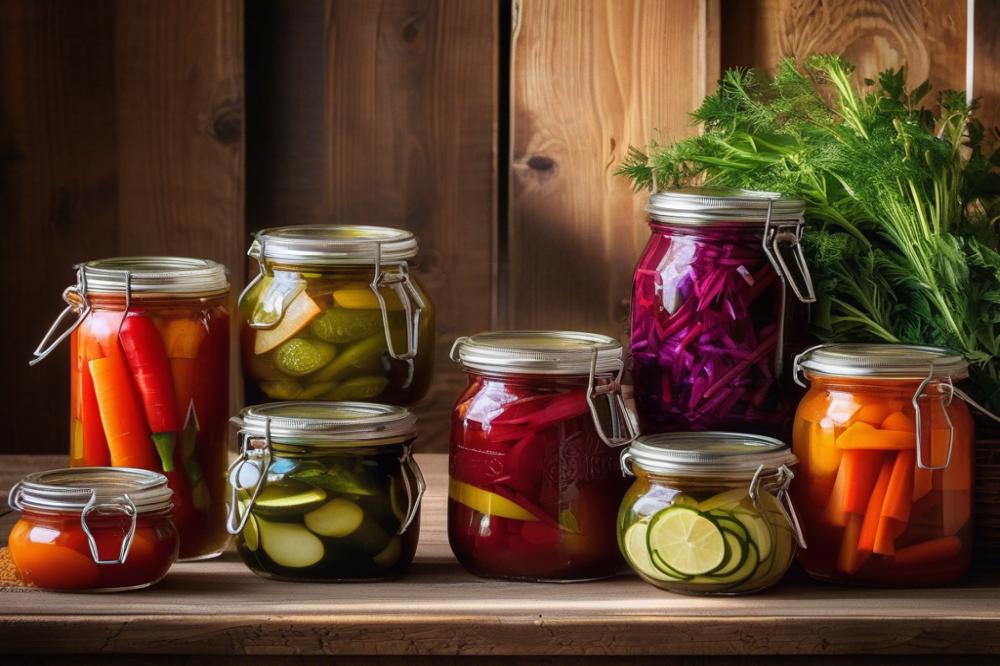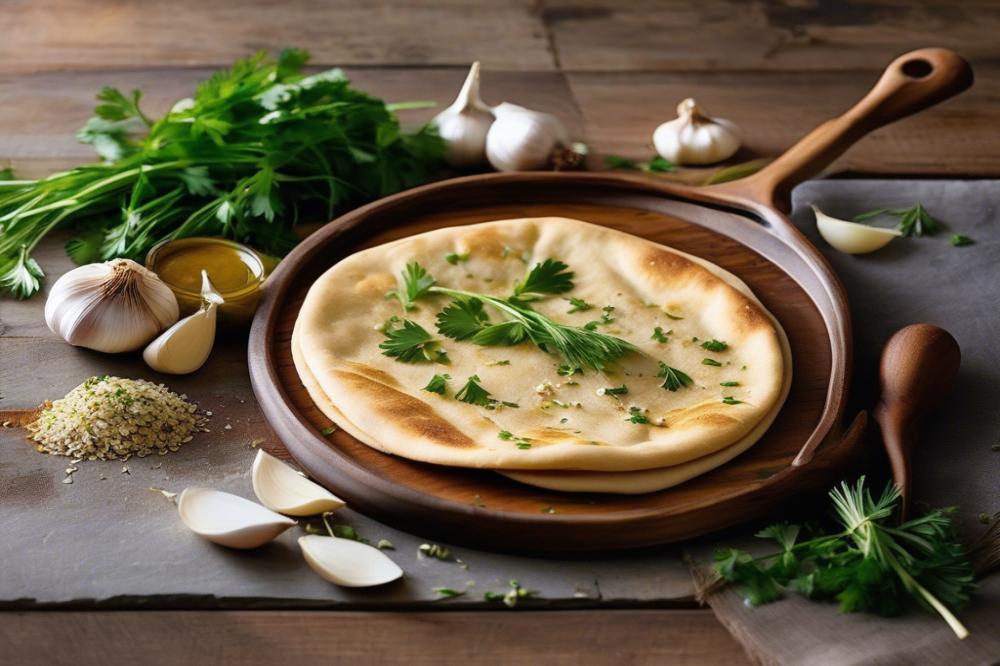Lebanese cuisine and the Role of pickled vegetables
Lebanese cuisine is a vibrant tapestry woven with bold flavors and diverse ingredients. It emphasizes fresh produce, fragrant spices, and wholesome grains. Among its many delights, pickled vegetables hold a special place. These tangy treats brighten meals and provide a burst of flavor that complements rich dishes.
Traditional recipes play a significant role in food preservation. Many cultures have developed methods to extend the shelf life of their food, and the Lebanese are no exception. Homemade pickles using vinegar brine not only preserve seasonal vegetables but also celebrate them. Families often pass down these recipes through generations, allowing the essence of their heritage to flourish.
The health benefits of pickled vegetables cannot be ignored. They offer a fantastic option for quick snacks that are both nutritious and flavorful. Incorporating fermented vegetables into everyday meals aligns perfectly with various Middle Eastern recipes. Such additions enhance culinary experiences while promoting healthier eating habits. A simple pickling recipe can transform ordinary veggies into delightful accompaniments that suit various palates.
Lebanese pickled vegetables contribute to a nuanced dining experience. One bite can transport you to the sunny shores of the Mediterranean. With their bright colors and zesty flavors, they remind us of the importance of preserving traditional foodways. Each jar encapsulates a culture’s history and dedication to sustain flavorful, healthful eating.
Lebanese pickled vegetables Recipe
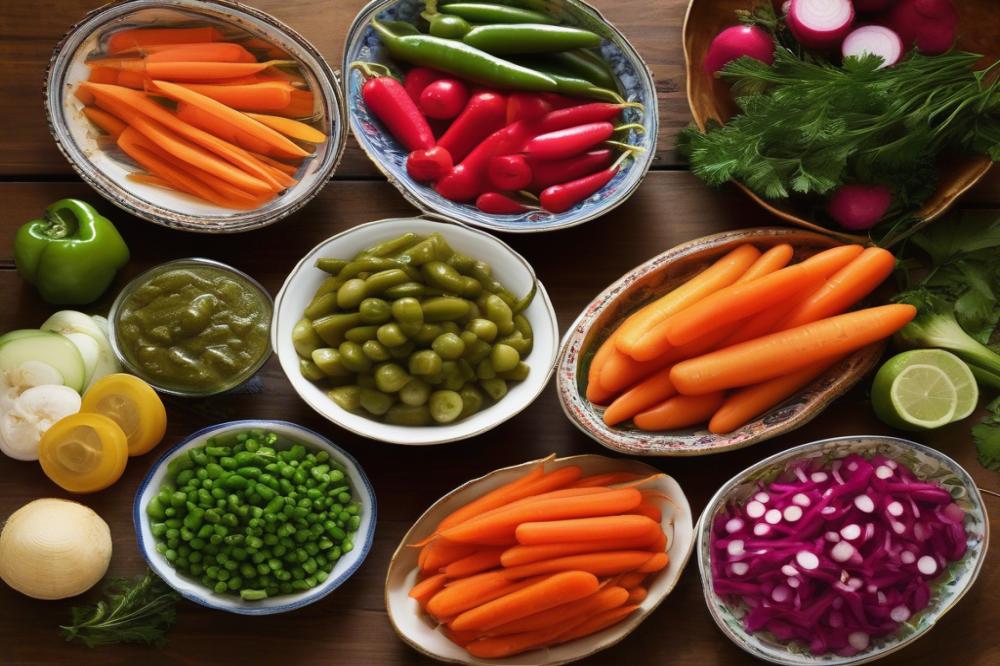
Ingredients List with Quantities
- Carrots (2 large)
- Cauliflower (1 small head)
- Radishes (1 bunch)
- Green bell pepper (1)
- Garlic cloves (5)
- White vinegar (2 cups)
- Water (1 cup)
- Salt (3 tablespoons)
- Sugar (2 tablespoons)
- Bay leaves (2)
- Whole black peppercorns (1 teaspoon)
Cooking Instructions Step-by-Step
Preparation of Vegetables
Start by washing all the vegetables thoroughly under cold water. Peel the carrots, then slice them into thin rounds or sticks, whichever you prefer. Remove the leaves and the root from the radishes before cutting them in half. Next, break the cauliflower into small florets. Finally, slice the green bell pepper into strips. As you prepare each vegetable, place them in a large bowl to gather all your ingredients together.
Combining Vinegar Brine
In a saucepan, combine the white vinegar, water, salt, and sugar over medium heat. Stir the mixture continuously until the sugar and salt dissolve completely. This vinegar brine is key to the flavor of your pickled vegetables. Once it reaches a gentle simmer, add the bay leaves and peppercorns to infuse additional taste. After a few minutes, remove from heat and let it cool slightly.
Packing and Processing the Vegetables
Now it’s time to pack the vegetables into sterilized jars. Carefully place the prepared carrots, cauliflower, radishes, and bell pepper into the jars, layering them nicely. Add garlic cloves between the layers for extra flavor. Pour the warm vinegar brine over the vegetables, ensuring everything is submerged. Seal the jars tightly with lids while leaving a little space at the top.
Fermentation Duration and Storage Tips
Leave the jars at room temperature for about 24 hours to allow fermentation to begin. After this time, you can transfer them to the refrigerator. The vegetables will continue to pickle and develop their flavors over the next few days. For the best taste, wait at least a week before digging in. Store in the fridge for up to a month. Enjoy these healthy snacks as part of your meals or on their own!
Nutrition Information
Each ingredient brings unique caloric and nutritional benefits. Carrots are rich in vitamins A and K, while cauliflower is a good source of fiber and antioxidants. Radishes add crunch and vitamin C. Bell peppers provide important vitamins like A and C, and garlic is known for its health-promoting properties. Altogether, these pickled vegetables offer a range of beneficial nutrients typically found in traditional recipes.
Picking homemade pickles is a fantastic way to bring vibrant flavors into your diet. Food preservation through pickling adds a unique twist to meals. These quick pickles can enhance daily eating habits, making them a delicious option in Middle Eastern recipes. Fermented vegetables are not only tasty, they also support gut health. Make this recipe part of your cooking routine, and enjoy the many advantages of homemade goodness!
Cultural Significance of Pickled Vegetables
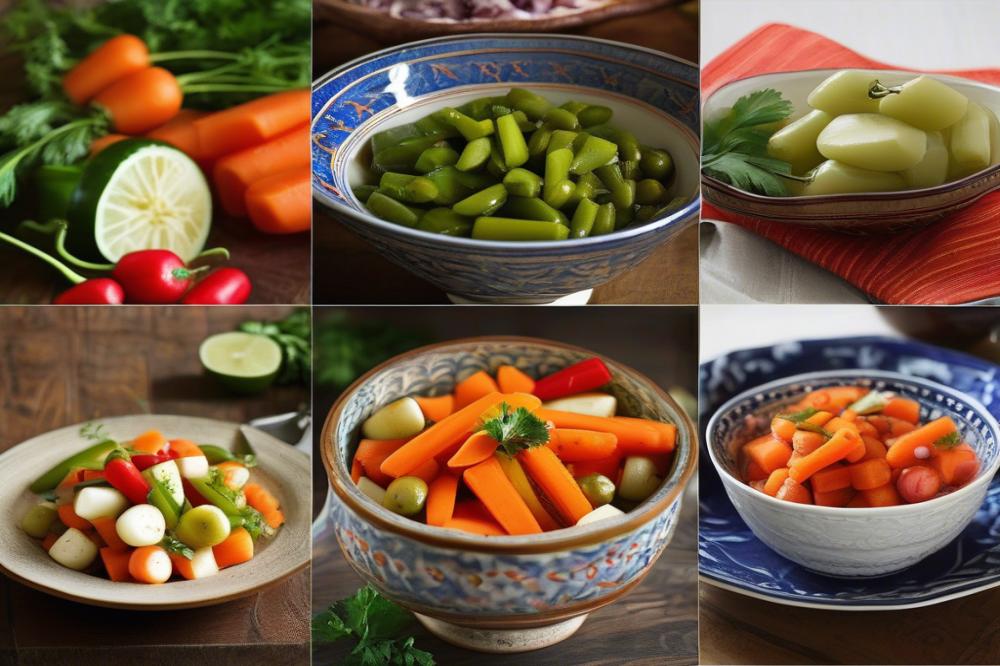
Pickled vegetables hold a special place in Lebanese cuisine. They are more than just side dishes; these tangy delights add flavor, color, and excitement to many meals. Often served with meats, rice, or flatbreads, they enhance the overall dining experience. Many families enjoy them as healthy snacks, showcasing the importance of these fermented vegetables in everyday life.
The tradition of preserving vegetables through pickling has deep roots in Lebanese culture. Before refrigeration, families relied on methods like vinegar brine for food preservation. Homemade pickles became essential to survive long winters. Each jar represents a burst of fresh flavor and a connection to the past. This practice reflects a resourceful approach to avoiding food waste.
Variations in pickled vegetables can be quite fascinating. Different regions in Lebanon have their own distinct recipes. Coastal areas might emphasize seafood alongside pickled produce, while mountainous regions may use local herbs and spices. Each family often has its own twist on traditional recipes, making flavors diverse and unique. Ingredients can include carrots, turnips, cucumbers, and cauliflower, each pickled to perfection.
Lebanese pickled vegetables share similarities with other Middle Eastern recipes. Many cultures in this region also enjoy pickling, celebrating the crunch and tang. Quick pickles are common in various countries, with each culture adding its spices and techniques. These preserved foods often find their place in mezze, the beloved array of appetizers served before main dishes. This similarity highlights the shared culinary heritage present in the Middle East.
Exploring Different Types of Pickled Vegetables
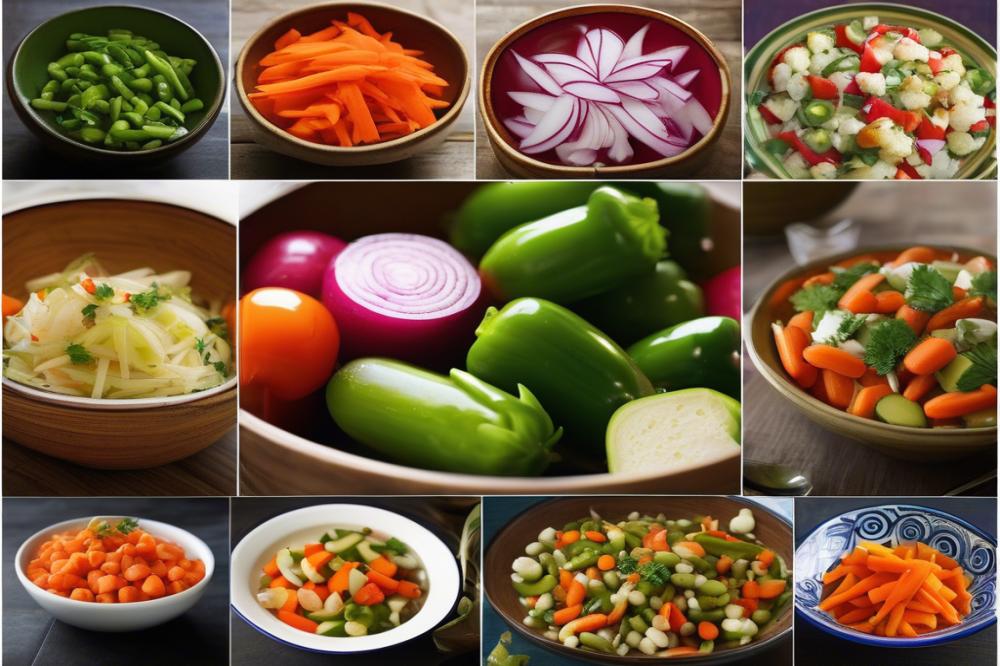
Quick Pickles vs. Fermented Vegetables
Quick pickles provide a fast way to enjoy flavorful vegetables. These are usually made with a vinegar brine, which can develop taste in just a few hours or overnight. The crunchiness remains intact, making them a great choice for a quick snack. Fermented vegetables, on the other hand, take longer to prepare. They rely on natural bacteria to develop flavor and preserve the veggies. This method adds a tangy taste and a softer texture that many find delightful. Both methods have their place in Lebanese cuisine, appealing to different tastes and preferences.
Popular Variations and Flavors in Lebanese Pickles
Many people enjoy the rich variety in Lebanese pickled vegetables. Common ingredients include cucumbers, carrots, and cauliflower. Each vegetable absorbs the brine differently, creating diverse flavors. Spices like garlic, coriander, and chili add an extra kick to the mix. Some recipes feature a touch of lemon, enhancing the overall brightness. Colorful arrangements in jars make these pickles a beautiful addition to any table. They can serve as side dishes or garnishes, adding flair to Middle Eastern recipes.
Suggestions for Other Vegetables to Pickle
While traditional options work well, many vegetables are suitable for pickling. Radishes have a crunchy texture and mild flavor that absorb brine nicely. Green beans are also a fun choice, providing a satisfying snap when bitten. Consider trying beets for a sweet, earthy touch. In addition, sliced bell peppers offer vibrant colors and a fresh taste. Experimenting with various vegetables can lead to new favorites. Homemade pickles invite creativity in the kitchen, allowing for customized flavors.
Flavor Profiles and Seasonings
Different seasonings can dramatically change the taste of pickled vegetables. Classic vinegar brine can be adjusted with sugar for sweetness or increased salt for a savory punch. An array of spices such as cumin or dill can create unique combinations. Homemade creations can reflect personal preferences and seasonal ingredients. The balance of acidity and spice is essential for an enjoyable outcome. Fresh herbs can also elevate the flavor, making the pickles more aromatic and appealing. Each bite should deliver a burst of taste, perfect for snacking or complementing meals.
Health Benefits of Lebanese Pickled Vegetables
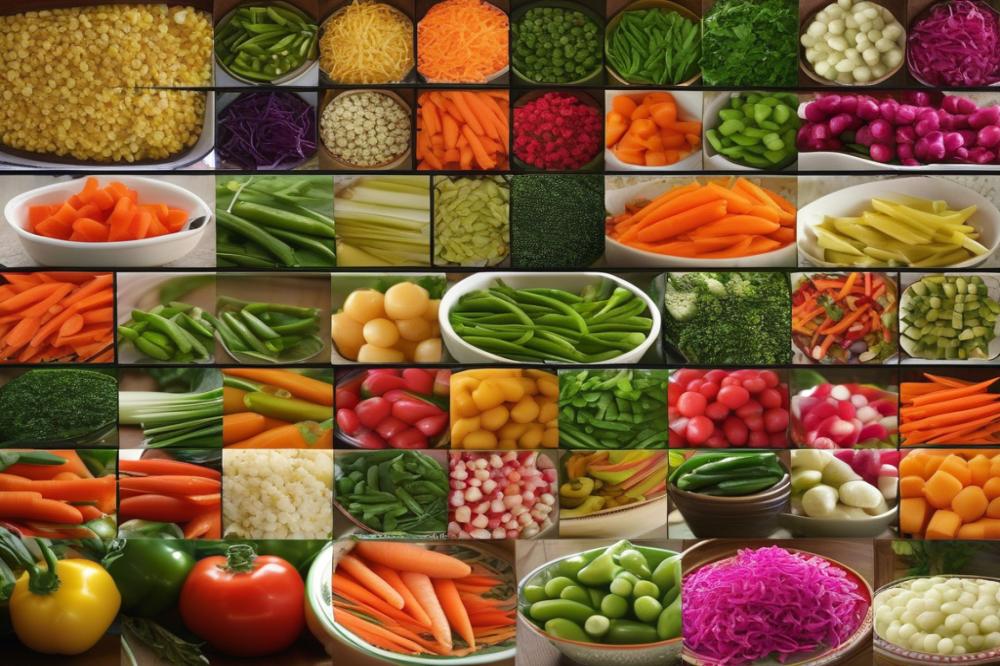
Incorporating pickled vegetables into your diet offers numerous nutritional advantages. Fermented vegetables undergo a unique transformation that enhances their health benefits. This process creates probiotics, which are beneficial bacteria that promote digestive health. They play a vital role in maintaining a balanced gut microbiome.
Choosing quick pickles as snacks can be a smart move for anyone looking for a healthy option. These snacks are typically low in calories but high in fiber. That fiber aids in digestion and helps you feel full, making them a smart choice for weight management. They also provide a burst of flavor that can make any meal more enjoyable.
Moreover, the vinegar brine used in pickling can act as a natural preservative. This is key in Lebanese cuisine, where food preservation is essential to keep dishes fresh longer. Traditional recipes often rely on this method, allowing families to enjoy these delights beyond the harvest season.
Including homemade pickles as part of a balanced diet can enhance overall health. They complement a variety of meals, adding excitement and taste. Pairing pickled vegetables with meats, grains, or cheeses can elevate simple dishes, allowing for a satisfying eating experience. It’s easy to craft your own versions, creating a delightful addition to any Middle Eastern recipes.
Final Thoughts on Lebanese Pickled Vegetables
Lebanese pickled vegetables are not just a delicious side dish; they are a connection to culture and tradition. These colorful and tangy bites add zest to any meal. Their presence on a table reflects the rich history of Lebanese cuisine and the significance of preserving seasonal flavors. Bringing a plate of these vibrant pickles to your next gathering will surely impress your friends and family.
Trying your hand at homemade pickles can be a rewarding experience. Creating something from scratch connects you to your food in a deeper way. You can customize the spices and ingredients according to your taste. This personal touch not only enhances the flavor but also makes the act of pickling feel special. Family recipes often hold stories that are passed down through generations. Making them at home can spark joy and cultivate a sense of pride.
Incorporating pickled vegetables into your diet plays a part in healthy eating. They are often low in calories but high in flavor, making them an excellent addition to meals. The fermentation process also encourages a healthy gut. Food preservation methods like pickling are not only practical but also tie us to our roots. Embracing traditional recipes enriches our understanding of various cultures. Let these time-honored dishes inspire creativity in your kitchen.
Don’t hesitate any longer. Delve into the world of pickling and explore the uniqueness of flavors that come with it. Your taste buds will thank you, and your meals will take on a whole new life. Grab some fresh vegetables and get started on this delightful culinary adventure!

